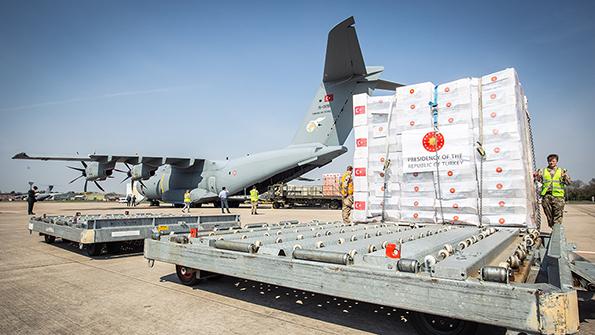
Just a few weeks ago, the idea that a Turkish military aircraft would perform a medical aid flight to the UK would have seemed extraordinary.
However, the April 10 mission from Turkey’s capital, Ankara, to RAF Brize Norton, England, flown by an Airbus A400M not only demonstrated Turkish President Recep Tayyip Erdogan’s soft power but also tested for the first time a NATO crisis-intervention initiative to speed up airlift missions across Europe.
- Rapid Air Mobility flights use the trigraph OAN.
- NATO wants diplomatic clearances to be fast-tracked in 24 hr.
The activation of NATO’s Rapid Air Mobility (RAM) capability by the North Atlantic Council on April 2 to help alliance members deal with the novel coronavirus pandemic removed the constraints associated with moving military airlifters across Europe.
Although the Turkish A400M carried much-needed medical protective gear destined for the UK’s National Health Service, RAM was originally developed so that NATO members could quickly reinforce their garrisons on the outer edges of the alliance, such as the Baltic States, with personnel and equipment at a time of growing crisis and support the alliance’s Very High-Readiness Joint Task Force (VJTF).
The initiative achieved an initial operating capacity last October.
“We decided there might be moments in this crisis for which this proves useful to move around medical supplies, patients or medical teams,” Camille Grand, NATO assistant secretary general for defense investment tells Aviation Week.
In peacetime, or during emergencies, military aircraft have to compete for airspace with commercial traffic and may not get the most efficient routings or slots.
In wartime, on the other hand, NATO would likely own the skies over Europe.
“COVID-19 is a different scenario to what we had anticipated [for RAM],” Grand says. “The airspace is not exactly crowded, but on the other hand, there are fewer air traffic controllers than in normal times. So it is not absurd to suggest that military flights should get priority.”
When activated, the plan—a collaboration between NATO and air traffic management agency Eurocontrol—prioritizes flight routings and fast-tracks the diplomatic clearance process.
A military flight from Spain to Poland, for example, may normally have to secure diplomatic clearances from 5-6 different countries before the departure date. Such clearances can take days or even weeks to acquire.
Nations that request a RAM flight, however, receive a special call sign with the trigraph OAN from Supreme Headquarters Allied Powers Europe (SHAPE). With an OAN call sign, diplomatic clearances are fast-tracked, and the flight can be waved through the airspace of different countries by air navigation service providers.
The Turkish Air Force flight used the call sign OAN2901 during its flight to the UK.
Under OAN, the allies have agreed to fast-track clearances in 48 hr., with the aim of reducing that to 24 hr.
NATO is also taking steps to request blanket diplomatic clearances so that OAN flights can receive automatic diplomatic clearances. This is in part driven by the need to reduce delays for flights, but it is also in recognition that the COVID-19 crisis has shut down government ministries that would normally supply such approvals.
The initiative was developed primarily for military aircraft, not for aircraft chartered by governments. But the alliance is “looking into whether it could be extended to other governmental or governmental-chartered aircraft,” Grand says. This would allow types such as the Antonov An-124 airlifters operated by Ukraine’s Antonov Airlines through the Strategic Airlift International Solution initiative also to use the OAN call sign.
The COVID-19 pandemic presents one of the biggest crises the military alliance has faced in its 70-year history, as it battles to help countries fight the virus but also remain at readiness. The alliance has already seen several major exercises canceled, including Cold Response in Norway, Frisian Flag in the Netherlands and the pan-European Defender-Europe exercise, which was due to test U.S. capabilities to rapidly deploy 20,000 troops and 13,000 pieces of equipment from the U.S. to Europe. It would have been the largest U.S. force to deploy to Europe in 25 years.
SHAPE has established a COVID-19 Task Force to coordinate logistical, transport and medical support to nations. NATO’s Euro-Atlantic Disaster Response Coordination Center has been receiving requests for assistance. So far, nine countries, including alliance members and partner nations, have made requests for assistance to NATO as a result of the COVID-19 crisis.





